Mitsui Chemicals, ARRK supply composites for Toyota concept car
Tafnex carbon fiber-reinforced PP and 3D printed components find application in Toyota Fortuner-based car designed by TCD Asia.
Mitsui Chemicals Inc. (Tokyo, Japan) and subsidiary ARKK Corp. (Osaka, Japan) have announced that materials developed by the two companies have been deployed in a high-performance concept car based on the Toyota Fortuner. Direct pellet-fed 3D printed components jointly developed by Mitsui Chemicals and ARRK, and Tafnex CF/PP — a unidirectional carbon fiber-reinforced polypropylene resin sheet developed by Mitsui Chemicals — have found application in the Toyota Hyper-F concept, which has been designed by TCD Asia Co. Ltd. (Bangkok, Thailand).
The Toyota Hyper-F concept is a high-performance concept model with a design that incorporates the road handling and aerodynamic performance cultivated in the racing field through TCD Asia’s motorsport business. The new materials have enabled the company to further reduce the concept car’s weight. In addition, the fitting of four sport seats provides a new mode of enjoyment. Tafnex CF/PP has been used for decorative components on part of the front bumper and the hood air vents, while the direct pellet-fed 3D printed components are fitted to the hood air duct bezels.
According to Mitsui Chemicals, the vehicle’s 3D printed components bring together the auto part design technology of Dreams Design Corp. (Nagoya, Japan) and ExtraBold’s Inc.’s (Tokyo, Japan) EXF-12 3D printer, which delivers high-speed printing of large parts. It also combines ARRK’s 3D printing and postprocessing technologies with Mitsui’s polyolefin-based composite materials specifically developed for use in 3D printing.
Hood air duct bezels (3D printed components; left) and decorative parts on the front bumper (Tafnex CF/PP).
Applying mechanisms used in injection molding, direct pellet-fed 3D printers form structures directly from plastic pellets. The advantage of this approach over conventional 3D printers is a stable increase in the quantity of plastic discharged, thereby enabling large structures to be formed quickly. When used in high-mix, low-volume mass production, the di-eless technique is said to help reduce development lead times and the initial investment required, including die costs. In addition, the technology is expected to contribute to the circular economy, as the 3D printed items can be crushed into pellets and recycled as raw materials for further 3D printing.
Tafnex CF/PP, on the other hand is highly rigid with good moldability, and boasts features that can be altered to suit a diverse range of designs, such as marble-like patterns. Tafnex is designed to be adapted for use in automotive and drones, along with a range of other applications in the industrial and consumer sectors. Such applications include local reinforcement of injected or pressed molded parts; the material can also be processed into parts in the form of tubes or laminated sheets.
This post is courtesy of the CompositesWorld and AZL Aachen GmbH media partnership.
Related Content
-
The potential for thermoplastic composite nacelles
Collins Aerospace draws on global team, decades of experience to demonstrate large, curved AFP and welded structures for the next generation of aircraft.
-
Pultrusion: The basics
A primer describing what pultrusion is, its advantages and disadvantages, and typical applications.
-
A new era for ceramic matrix composites
CMC is expanding, with new fiber production in Europe, faster processes and higher temperature materials enabling applications for industry, hypersonics and New Space.


















